India: $300 Billion Wanted In Oil Investments Over Next 10 Years 13/07/17 •lweb.es/f2884 •bit.ly/2udblTN
 “India is the place where there is incremental demand,” Oil Minister Dharmendra Pradhan has said. “Our per capita energy consumption is one-fourth of the world. In India, there is an emerging middle class and they are aspirational. Per capita energy consumption is going to increase. So, we need energy. There is no shortcut around that.” The country needs investments to boost the production of natural gas and crude oil, and to refine, transport and distribute the fuel to households. India’s state-run companies are scouring the world for access to reserves and technology.
“India is the place where there is incremental demand,” Oil Minister Dharmendra Pradhan has said. “Our per capita energy consumption is one-fourth of the world. In India, there is an emerging middle class and they are aspirational. Per capita energy consumption is going to increase. So, we need energy. There is no shortcut around that.” The country needs investments to boost the production of natural gas and crude oil, and to refine, transport and distribute the fuel to households. India’s state-run companies are scouring the world for access to reserves and technology.


 On simple accounting terms Saudi Arabia, Iraq and Iran can generate profits with oil prices at $20 to $40 per barrel. U.S. shale by contrast requires about $50 to $55 per barrel. If one looks at the fiscal break-even price, OPEC producers require an estimated $70 per barrel this year, higher than the $40 to $60 required by listed energy companies to fund capital expenditure and dividends. With respect to external break-evens, i.e. the oil prices needed to foot import bills, the spectrum is wide: Libya needs $140 a barrel and Norway needing just $20.
On simple accounting terms Saudi Arabia, Iraq and Iran can generate profits with oil prices at $20 to $40 per barrel. U.S. shale by contrast requires about $50 to $55 per barrel. If one looks at the fiscal break-even price, OPEC producers require an estimated $70 per barrel this year, higher than the $40 to $60 required by listed energy companies to fund capital expenditure and dividends. With respect to external break-evens, i.e. the oil prices needed to foot import bills, the spectrum is wide: Libya needs $140 a barrel and Norway needing just $20. China aims to build a world-class nuclear energy innovation hub in Shanghai, planning to become a global nuclear forerunner and establishing itself as a nuclear tech leader, high-end facility manufacturer and exporter.
China aims to build a world-class nuclear energy innovation hub in Shanghai, planning to become a global nuclear forerunner and establishing itself as a nuclear tech leader, high-end facility manufacturer and exporter. 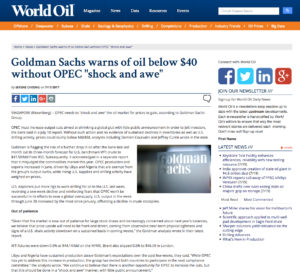 Goldman Sachs says that OPEC must increase output cuts aimed at shrinking a global glut with little public announcement in order to jolt investors. Without such action and no evidence of sustained declines in inventories as well as U.S. drilling activity, prices could slump below $40. “We continue to believe that there is another opportunity for OPEC to increase the cuts, but that this should be done in a “shock and awe” manner, with little public announcement.” Deeper cuts are currently not on the agenda, according to OPEC Secretary-General Mohammad Barkindo.
Goldman Sachs says that OPEC must increase output cuts aimed at shrinking a global glut with little public announcement in order to jolt investors. Without such action and no evidence of sustained declines in inventories as well as U.S. drilling activity, prices could slump below $40. “We continue to believe that there is another opportunity for OPEC to increase the cuts, but that this should be done in a “shock and awe” manner, with little public announcement.” Deeper cuts are currently not on the agenda, according to OPEC Secretary-General Mohammad Barkindo.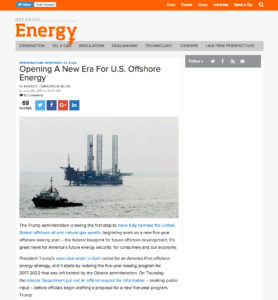 The Trump administration is beginning work on a new five-year offshore oil and gas leasing plan – the federal blueprint for future offshore development – in the Atlantic and Pacific Oceans, the Eastern Gulf of Mexico and the Arctic. This is a redo of the Obama administration’s programme for 2017-2022 and seeks public input before officials begin drafting proposals. Currently, 94 percent of federal offshore acreage is off limits to development, with natural gas and oil production being hindered by a lack of access to areas controlled by Washington.
The Trump administration is beginning work on a new five-year offshore oil and gas leasing plan – the federal blueprint for future offshore development – in the Atlantic and Pacific Oceans, the Eastern Gulf of Mexico and the Arctic. This is a redo of the Obama administration’s programme for 2017-2022 and seeks public input before officials begin drafting proposals. Currently, 94 percent of federal offshore acreage is off limits to development, with natural gas and oil production being hindered by a lack of access to areas controlled by Washington. 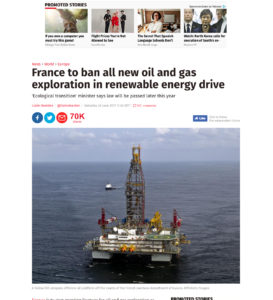 France is to stop granting licences for oil and gas exploration as part of a transition towards environmentally-friendly energy. Nicolas Hulot, the “ecological transition” minister said a law would be passed in the autumn.
France is to stop granting licences for oil and gas exploration as part of a transition towards environmentally-friendly energy. Nicolas Hulot, the “ecological transition” minister said a law would be passed in the autumn. 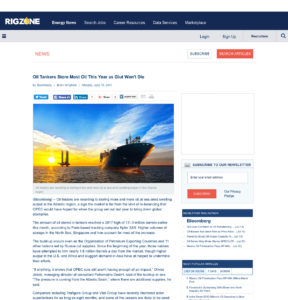 Oil traders are storing more oil at sea amid swelling output in the Atlantic region, a sign the market is far from the kind of re-balancing that OPEC would have hoped for. The amount of oil stored in tankers reached a 2017 high of 111.9 million barrels early June, and higher volumes of storage in the North Sea, Singapore and Iran account for most of the increase. Oil in floating storage has been building at a rate of about 800,000 barrels a day since early May and continues to increase, said a Morgan Stanley report.
Oil traders are storing more oil at sea amid swelling output in the Atlantic region, a sign the market is far from the kind of re-balancing that OPEC would have hoped for. The amount of oil stored in tankers reached a 2017 high of 111.9 million barrels early June, and higher volumes of storage in the North Sea, Singapore and Iran account for most of the increase. Oil in floating storage has been building at a rate of about 800,000 barrels a day since early May and continues to increase, said a Morgan Stanley report.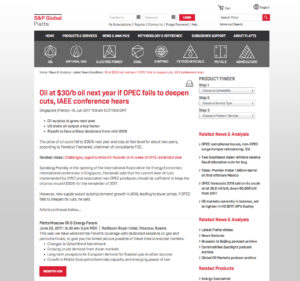 The price of oil could fall to $30 next year and stay at that level for about two years, according to Fereidun Fesharaki, chairman of consultants FGE. He said that the current level of cuts implemented by OPEC should keep the oil price around $50 a barrel for the remainder of 2017, but a failure to deepen these cuts would lower prices. Fesharaki stated that the key question was whether there was a limit to US Light Tight Oil production, or whether a boom in shale oil production in Argentina would occur.
The price of oil could fall to $30 next year and stay at that level for about two years, according to Fereidun Fesharaki, chairman of consultants FGE. He said that the current level of cuts implemented by OPEC should keep the oil price around $50 a barrel for the remainder of 2017, but a failure to deepen these cuts would lower prices. Fesharaki stated that the key question was whether there was a limit to US Light Tight Oil production, or whether a boom in shale oil production in Argentina would occur.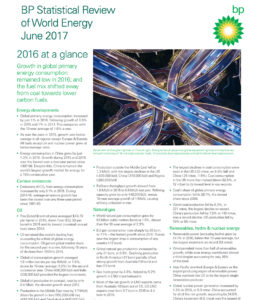 According to the 2017 BP Statistical Review, rapid growth and improving prosperity mean growth in energy demand is increasingly coming from developing economies, particularly within Asia, rather than from traditional markets in the OECD. However, the drive to improve energy efficiency is causing global energy consumption overall to decelerate. Global carbon emissions are improving, and this can be traced back to the changes in the pace and pattern of economic growth and energy consumption within China. Globally, wind and solar power grew strongly, accounting for almost a third of the increase in primary energy last year.
According to the 2017 BP Statistical Review, rapid growth and improving prosperity mean growth in energy demand is increasingly coming from developing economies, particularly within Asia, rather than from traditional markets in the OECD. However, the drive to improve energy efficiency is causing global energy consumption overall to decelerate. Global carbon emissions are improving, and this can be traced back to the changes in the pace and pattern of economic growth and energy consumption within China. Globally, wind and solar power grew strongly, accounting for almost a third of the increase in primary energy last year. US crude exports averaged more than 1 million barrels a day in April, driven by the significant discount of US crude prices relative to global benchmarks. New infrastructure, like the 520,000 barrels a day Dakota Access Pipeline, has reduced costs to move crude to the Gulf Coast, while major projects are underway at US Gulf Coast ports that will increase the region’s export capacity. These outward flows have served as an outlet for rising US crude production and have displaced other barrels that have struggled to then find a home.
US crude exports averaged more than 1 million barrels a day in April, driven by the significant discount of US crude prices relative to global benchmarks. New infrastructure, like the 520,000 barrels a day Dakota Access Pipeline, has reduced costs to move crude to the Gulf Coast, while major projects are underway at US Gulf Coast ports that will increase the region’s export capacity. These outward flows have served as an outlet for rising US crude production and have displaced other barrels that have struggled to then find a home.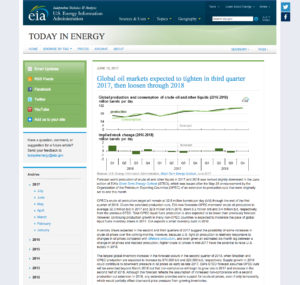 Inventory draws expected in the second and third quarters of 2017 suggest the possibility of increases in oil prices over the coming months. However, because U.S. tight oil production is relatively responsive to price changes, higher oil prices in mid-2017 have the potential to raise U.S. supply in 2018. The largest global inventory increase may occur in the second quarter of 2018, when Brazilian and OPEC production are expected to increase by 570,000 b/d and 220,000 b/d, respectively. Supply growth in 2018 could contribute to downward pressure in oil prices as early as late 2017.
Inventory draws expected in the second and third quarters of 2017 suggest the possibility of increases in oil prices over the coming months. However, because U.S. tight oil production is relatively responsive to price changes, higher oil prices in mid-2017 have the potential to raise U.S. supply in 2018. The largest global inventory increase may occur in the second quarter of 2018, when Brazilian and OPEC production are expected to increase by 570,000 b/d and 220,000 b/d, respectively. Supply growth in 2018 could contribute to downward pressure in oil prices as early as late 2017. 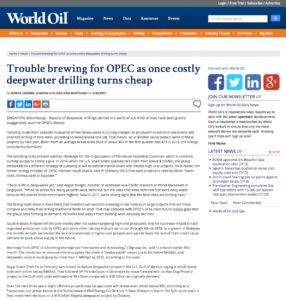 Pumping crude from deepwater areas is turning cheaper, and an oil price of $50 a barrel could sustain some of these projects by next year. Royal Dutch Shell has already sanctioned its Kaikias deepwater project in the Gulf of Mexico, saying it would break even with prices below $40/b, and BP has decided to move forward with its Mad Dog Phase 2 project also in the Gulf, with costs estimated at $9 billion compared to $20 billion as originally planned. Over the next three years, eight offshore projects may be approved with break-even prices below $50.
Pumping crude from deepwater areas is turning cheaper, and an oil price of $50 a barrel could sustain some of these projects by next year. Royal Dutch Shell has already sanctioned its Kaikias deepwater project in the Gulf of Mexico, saying it would break even with prices below $40/b, and BP has decided to move forward with its Mad Dog Phase 2 project also in the Gulf, with costs estimated at $9 billion compared to $20 billion as originally planned. Over the next three years, eight offshore projects may be approved with break-even prices below $50. The outlook for global independent exploration and production firms remains positive, according to Moody’s. Increased oil and natural gas production, higher commodity prices, and moderate cost increases will help independent business’ earnings grow at a healthy pace over the next 12-18 months. The global E&P sector EBITDA – Earnings Before Interest, Taxation, Depreciation and Amortization – is expected to grow by 20-30% in 2017, following declines of about 25% in 2016 and a roughly 45% drop in 2015. The sector’s oil and natural gas production will rise about 5%, and mergers and acquisitions will be robust.
The outlook for global independent exploration and production firms remains positive, according to Moody’s. Increased oil and natural gas production, higher commodity prices, and moderate cost increases will help independent business’ earnings grow at a healthy pace over the next 12-18 months. The global E&P sector EBITDA – Earnings Before Interest, Taxation, Depreciation and Amortization – is expected to grow by 20-30% in 2017, following declines of about 25% in 2016 and a roughly 45% drop in 2015. The sector’s oil and natural gas production will rise about 5%, and mergers and acquisitions will be robust.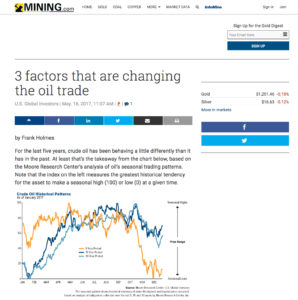 This article considers three principal drivers for the oil trade: technology, weather and OPEC policy: • Fracking technology is highly influential: The graphs “Crude oil historical patterns”, showing changes over the last 5 years compared to the last 15 and 30 years, and the graph “US Crude oil production” from1983 to 2017, show the relevant impact.• Extreme weather: A growing number of weather events costing $1 billion have been experienced, as well as significant losses in production. • OPEC strategy is less effective now… The graphic “Does OPEC policy influence prices anymore?” asks a very pertinent question.
This article considers three principal drivers for the oil trade: technology, weather and OPEC policy: • Fracking technology is highly influential: The graphs “Crude oil historical patterns”, showing changes over the last 5 years compared to the last 15 and 30 years, and the graph “US Crude oil production” from1983 to 2017, show the relevant impact.• Extreme weather: A growing number of weather events costing $1 billion have been experienced, as well as significant losses in production. • OPEC strategy is less effective now… The graphic “Does OPEC policy influence prices anymore?” asks a very pertinent question.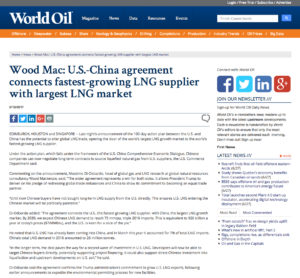 A new agreement between the U.S. and China has the potential to alter global LNG trade, opening the door of the world’s largest LNG growth market to the world’s fastest-growing LNG supplier.
A new agreement between the U.S. and China has the potential to alter global LNG trade, opening the door of the world’s largest LNG growth market to the world’s fastest-growing LNG supplier.  Africa’s government may award its first shale gas exploration licenses by the end of September, after environmental objections delayed the process.
Africa’s government may award its first shale gas exploration licenses by the end of September, after environmental objections delayed the process. 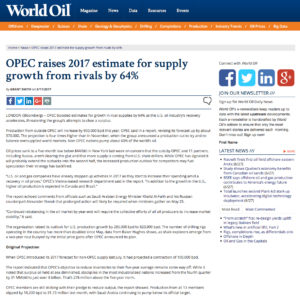 OPEC boosted its estimates for growth in oil supplies from rival Non-OPEC producers by 64% as the U.S. oil industry’s recovery accelerates, threatening attempts by the organization and its partners to clear a surplus. Production from outside OPEC will increase by 950,000 barrels a day this year, OPEC said, revising its forecast up by about 370,000 b/d. U.S. oil and gas companies have already stepped up activities as they start to increase their spending amid a recovery in oil prices, and higher oil production is also expected in Canada and Brazil.
OPEC boosted its estimates for growth in oil supplies from rival Non-OPEC producers by 64% as the U.S. oil industry’s recovery accelerates, threatening attempts by the organization and its partners to clear a surplus. Production from outside OPEC will increase by 950,000 barrels a day this year, OPEC said, revising its forecast up by about 370,000 b/d. U.S. oil and gas companies have already stepped up activities as they start to increase their spending amid a recovery in oil prices, and higher oil production is also expected in Canada and Brazil. The worst crude-market crash in a generation has propelled energy companies into the digital world. Now they’re using DNA sequencing to track crude molecules and mapping buried streams with imaging software. Robots are fitting pipes together. Roughnecks consult mobile apps for drilling-direction advice. Algorithms adjust the extraction flow based on computer monitoring hundreds of feet below. “You’ve had a clear shift occur where onshore North America for the first time in recent history has become a technology play.” said Tom Curran, an energy analyst at FBR Capital Markets.
The worst crude-market crash in a generation has propelled energy companies into the digital world. Now they’re using DNA sequencing to track crude molecules and mapping buried streams with imaging software. Robots are fitting pipes together. Roughnecks consult mobile apps for drilling-direction advice. Algorithms adjust the extraction flow based on computer monitoring hundreds of feet below. “You’ve had a clear shift occur where onshore North America for the first time in recent history has become a technology play.” said Tom Curran, an energy analyst at FBR Capital Markets.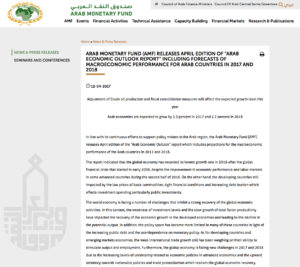 According to an Arab Monetary Fund analysis, most of the Arab oil-exporting countries have had to readjust owing to unfavorable global economic developments.
According to an Arab Monetary Fund analysis, most of the Arab oil-exporting countries have had to readjust owing to unfavorable global economic developments.